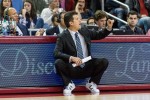When USC coach Andy Enfield decided to switch from man-to-man to a zone defense eight minutes into his team’s win over UCLA on Jan. 25, the UCLA offense immediately stalled out.
The Bruins turned the ball over 11 times in the final 12 minutes of the first half, as the Trojans erased a 10-point deficit to build a 12-point halftime lead.
It was as if UCLA had never seen a zone defense before.
That wasn’t true, of course – but it had been a while since UCLA had dealt with a zone for an extended stretch.
Heading into that matchup with USC – in which the Trojans utilized a zone on 47 half-court possessions – the Bruins had run just 21 possessions against a zone over their previous six games combined, per Synergy Sports.
Three of those six opponents – Arizona, Colorado and Stanford – employed exclusively man-to-man defense, and two other opponents – Arizona State and California – lined up in a zone for just one or two possessions. Only Utah used a zone for an extended stretch, going to it for 18 possessions.
So when Enfield decided to trot out the Trojans’ zone in the teams’ first meeting, it gave the Bruins trouble.
When they weren’t throwing the ball away to the Trojans, the Bruins seemed indecisive about their movements, and were mostly glued to the perimeter.
“We stood a lot,” coach Steve Alford said. “When you face zones, you’ve got to be able to get it inside and I didn’t think we did that.”
Alford leaned heavily on his four-guard lineup in that game – both to speed up his team’s comeback effort with pace and shooting, and also to match up with the four-guard unit Enfield used for much of the game.
In retrospect, Alford said, that played into the opponent’s hands.
“Playing four guards in the second half was a mistake,” Alford said Tuesday. “We hadn’t seen a lot of zone, so the four-guard lineup had not even practiced a lot – let alone had game experience – against zone.”
Over their four-game winning streak since that loss at the Galen Center, the Bruins have had plenty of opportunities to sharpen their zone offense, running 80 possessions against zone and scoring on nearly half of them.
Freshman point guard Lonzo Ball, who turned the ball over seven times in the first meeting with USC and blamed himself for the loss afterward, has led the team’s improvement.
Though he turned the ball over three times against Oregon, Ball has begun to find ways for his remarkable skill set to function against zones.
His deep 3-point range is well-documented, and he used it to drill plenty of 3s over the past few games, including four against Washington’s zone. But he’s also showed he can achieve the tougher task of getting into the paint off the dribble against a zone.
Ball has been more aggressive in general over the past four games, averaging 18.6 points per game by taking advantage of defenses that are afraid of his passing.
